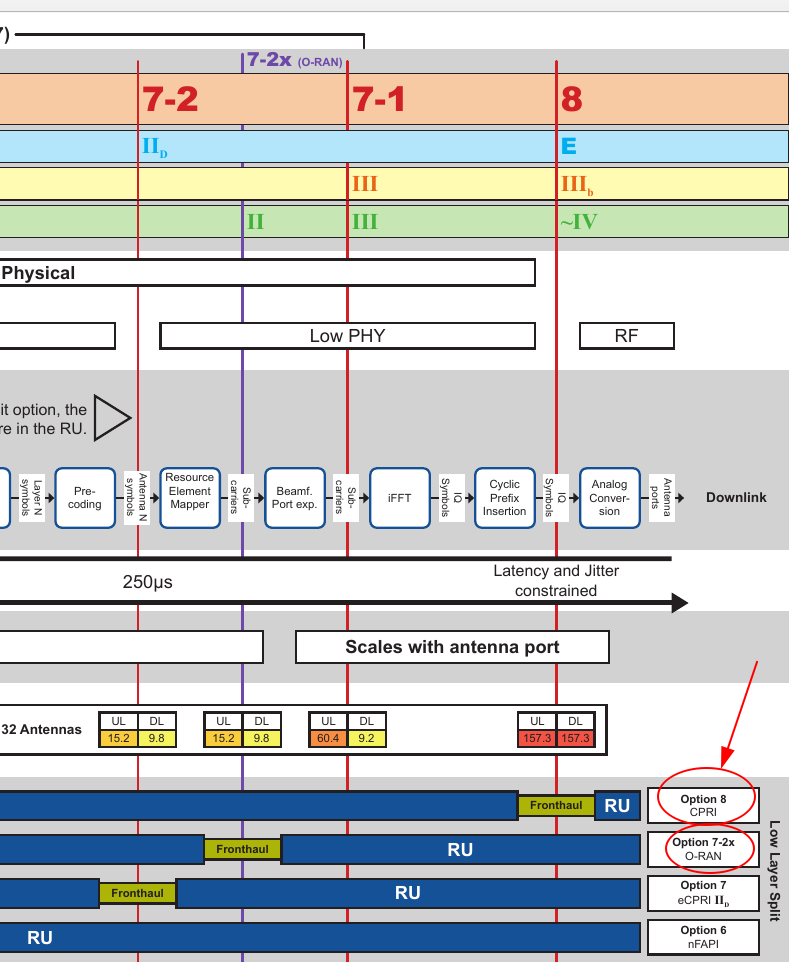
When people ask me for the ‘elevator pitch’ on ORAN my quick summary is that Open-RAN aims to:
1) separate hardware from software;
2) put all software that does not require dedicated hardware on virtualized (x86) servers or into containers ‘in the cloud’ and use high speed fiber links to connect to the remaining hardware (and software) at the distributed cell sites;
3) provide standardized interfaces between components in the RAN so software and hardware can come from different vendors.
4) increase competition to foster innovation and reduce prices.
There are lots of interfaces standardized in ORAN and each has its individual story of how and why. One interface of particular interest to me is the fiber connection between the digital baseband unit at a cell site, usually at the lower end of a tower, and the radio unit which is usually located at the top of a tower close to the antennas. This part of the RAN is also referred to as the ‘fronthaul‘ and the CPRI protocol is used to exchange data over the link. So how does that work today and how does ORAN want to change this interface to become more flexible and open?
Before going on, let’s have a quick look at what the baseband and radio unit actually do:
Baseband, Radio Unit and CPRI
From a very high-level point of view (with some simplifications), the LTE / 5G baseband unit receives IP packets from the core network for all mobile subscribers that are currently served by this cell site. The baseband then chops up the IP packets into small chunks that can be transmitted over the air interface and decides which chunks of data should end up on which sub-carriers at a certain point in time, which sub-carriers are used for which users at a certain point in time and how many simultaneous data streams (MIMO) should be used for a particular subscriber in combination with beamforming and other neat tricks. The result of all these efforts is a digital data stream for each physical antenna encoded in digital IQ values. Have a look at this post from 2016 if you are not sure what IQ values are. These digital IQ values are then sent over the CPRI interface to the radio unit.
At the other end of the fiber, the radio unit receives the digital IQ symbols and converts them into an RF signal. That’s a straightforward and simple task as the IQ values represent the RF signal. The radio unit then amplifies the resulting RF signal and forwards it to the antenna which in turn sends the signal to the user’s device. For uplink data received from a user’s device the process works in the opposite direction.
Let’s Get Back to ORAN
Unfortunately, apart from the rather dry specifications, there is very little explanatory technical information on the net about CPRI and eCPRI and how ORAN aims to standardize and use the fronthaul interface between the baseband and the radio unit. However, I found this fantastic poster in PDF format from Huber + Suhner which has all the details about different fronthaul options. A treasure trove!!! The image above is an excerpt from this PDF that focuses on the CPRI/eCPRI/ORAN part of the story I want to look at in this post.
As per the elevator pitch above the aim of ORAN for the front haul is to make the hardware independent of the software and to allow network operators to buy hardware and software for the distributed part of the baseband unit from one set of vendors and the hardware and software of the radio unit from another set of vendors.
As can be seen in the poster, CPRI is the ‘Lower Layer Split 8’ option in 3GPP parlance and transmits digital IQ symbols as described above. However, there are two challenges:
Problem 1: The way the baseband and the radio module exchange operation and maintenance information is not standardized, so different vendors have implemented their own protocols over CPRI. In other words, it’s not possible to decouple baseband hardware and software from radio module hardware and software.
Problem 2: Especially for 100 MHz 5G NR channels, the datarate over CPRI even for a single sector is well beyond 100 Gbit/s according to the poster. One can use CPRI compression, fewer MIMO layer and other tricks, etc. but this doesn’t scale well and is pretty limiting.
eCPRI to the Rescue
ORAN tackles those two issues as follows: Instead of using the CPRI specification, ORAN uses the newer eCPRI specification and standardizes communication over it. To reduce the datarates, ORAN uses 3GPP Split Option 7-2x a bit higher up in the RAN protocol stack in two different flavors, Category A and Category B:
[NOTE: 3.8.2022, I modified this paragraph significantly]: In the 7-2x CAT-A flavor, the ORAN distributed unit (let’s call it the baseband) converts the digital data stream into (digital) IQ symbols, and assigns them to one or more (MIMO) layers. This IQ (MIMO) layer information is then sent over the fiber. The increase in data rate compared to the original digital data stream is relatively modest. For 256-QAM modulation (8 bits mapped to one transmission step) could for example be mapped to 2x 8 bit I/Q symbol information. So the datarate approximately doubles.
In the 7-2x CAT-B flavor, additional processing steps are done in the ORAN distributed unit (baseband). One of them is to calculate the IQ symbols for each antenna port. This significantly increases the data rate, particularly for antenna arrays with 32 or 64 antenna ports. Instead of 4 (MIMO) data streams, there are suddenly 32 or 64 antenna port data streams, i.e. the data rate required for this is much higher.
So there we go, this is the core of what you need to know about the ‘fronthaul’ and the different ways of how data is sent to and from the radio module over a fiber cable at a cell site!